Sight words are terms that students do not need to sound out and that they will recognize instantly, by simply seeing them. When students have these terms mastered, it will make their reading level progress faster. Below you will find 15 worksheets that take students on a journey towards a destination of actively using sight words and practice using them in a sentence. Some of the worksheets teach how to achieve certain styles of handwriting while working on learning new sight words. The printable worksheets are perfect teaching tools that your students can bring home for extra practice. They will help prereaders and help students identify and understand very common words. This is usually step one towards becoming a fluent reader. Once students master these words, they can move on to small sentence (5-7 words) reading and even writing.
Printable Sight Words Worksheets
Click the buttons to print each worksheet and answer key.


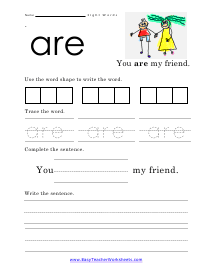
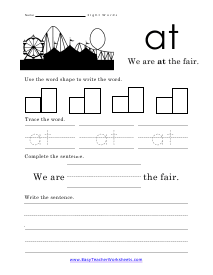
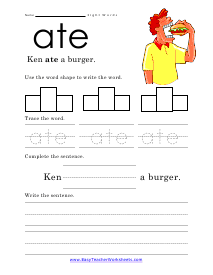
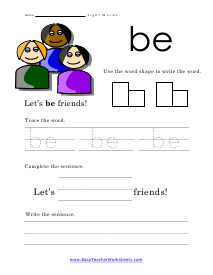
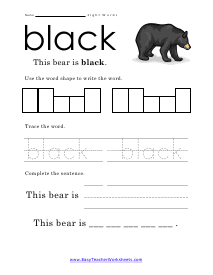
black (The Word)
This bear is black. This give the reader a descriptive fact about the subject of a sentence.
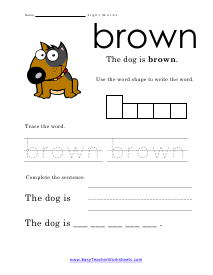
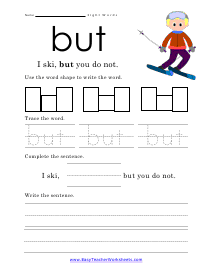
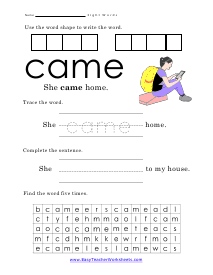
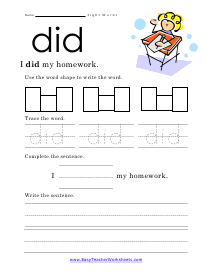
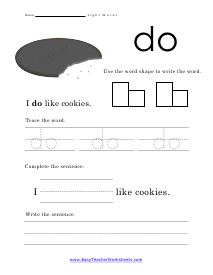
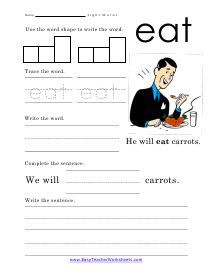
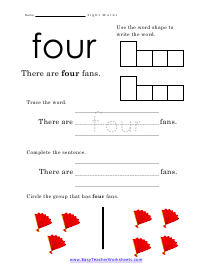
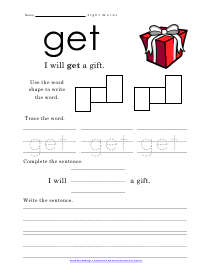
What Are Sight Words and How Do They Help?
Are there some words that you just seem to see more often than not when reading? You bet ya! There are roughly one hundred vocabulary terms that will be present in half of what we read. In the 1930s an educator names Edward William Dolch recognized this and realized that there are some words that readers should automatically know. He created a list of two hundred and twenty words and ninety-five nouns that are of high occurrence. He encouraged children to focus on these vocabulary terms to become better readers. In the 1980s this list got an update by Edward Fry. The list expanded to one thousand in all. It is estimated that the Fry list is found in roughly ninety percent of what we read and write. Although the digital age seems to have made handwriting obsolete, reality is much different. Also referred to as penmanship, hand writing takes considerable practice to create a unique style that appeals to readers.
As every student progresses in grade level, they learn new vocabulary terms and how to use them. Sometimes they encounter words that they don’t understand or cannot memorize no matter how many times they try. One thing that students become familiar with is sight words.
Sight words frequently occur in a text and are also referred to as high-frequency words. As the name suggests, they are words that a student is expected to know at first sight. These include terms like "and," "it," and "the," occur so frequently in texts that readers don't have to sound them out and recognize them at sight.
How Sight Words Help?
Building up a base of vocabulary terms helps the students to read faster and be more fluent when reading, as they no longer have to pause and read them. They are essential for students to master because they can account for up to 75% of printed material. There are many other benefits to sight words than just being able to read them. Some of these benefits include:
- They promote comprehensive reading. A student can better focus on important words inside a text than spend their time reading and deciphering all the terms. This saves time and strengthens understanding of the text.
- They provide context to the text. It becomes easier for students to understand the meaning of a text when they become familiar with sight words, as they can link different sentences together to form a better understanding.
- They increase confidence. After familiarizing themselves with these terms, students can recognize at least 50% of the sentence. This prevents students from getting confused and discouraged and builds their confidence in their understanding of a text.
Example of Sight Words
They are divided based on grade level. One of the most common lists of sight words taught in schools is the Dolch Word List, which contains 220 non-nouns and 95 high-frequency nouns. The Dolch Word List contains a series of terms up to the third-grade level, but teachers often use other lists from fourth grade onwards. The Dolch World List is divided into five levels of difficulty:
1. Pre-Primer - 40
2. Primer - 52
3. First Grade - 41
4. Second Grade - 46
5. Third Grade - 41
Some examples of sight words that educators teach per grade level are as follows:
Kindergarten: be, but they, was, what, with, do, have, etc.
First Grade: could, then, when, again, her, his, after, from, etc.
Second Grade: because, before, which, around, write, etc.
Third Grade: better, own, only, together, laugh, etc.
Fourth Grade: complete, measure, question, usually, area, piece, etc.
Fifth Grade: quick, special, language, among, produce, etc.
You can find the list of words here or here.
How to Learn Sight Words
Although learning sight words is mostly about memorizing them, there are still certain tips you can follow to make it easier.
Choose words per day. Do not try to learn all the words in one go; instead, try to memorize five words daily.
Practice the words daily for around 15 minutes every day. The more you use them, the more you remember them.
Read more. As mentioned before, sight words are high-frequency words. Reading more will get you used to certain words faster.
To Sum Up
Sight words are a great tool to have at your disposal, making reading easier and faster. Although it may seem tedious, once you’ve memorized sight words, you will never forget them.
Keep practicing until you've mastered sight words. Practice makes perfect!

